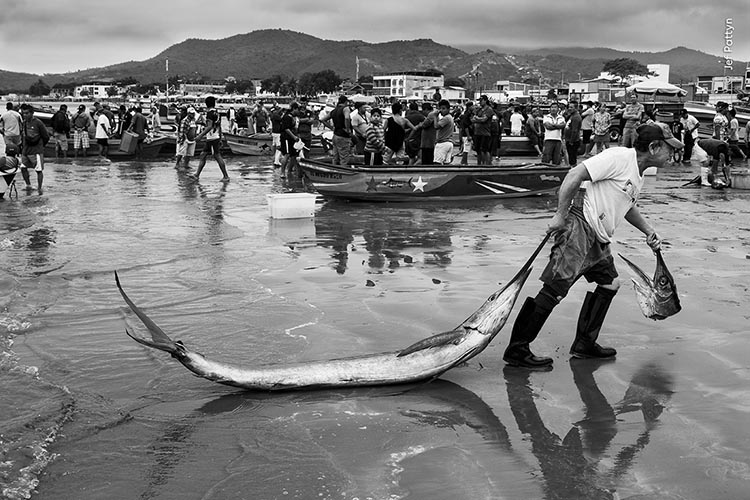
The Natural History Museum has provided a sneak peek at some of the most outstanding photographs submitted to this year’s Wildlife Photographer of the Year competition, including some beautiful ocean-themed images.
The 2023 edition of Wildlife Photographer of the Year attracted 49,957 entries from photographers of all ages and experience levels, from 95 different countries. The panel of judges, chaired by former Deputy Director of Photography at National Geographic Magazine has whittled the staggering number of submissions down to a top 100, which will be displayed at the Natural History Museum in London, from 13 October 2023.
The sixteen preview pictures (click here for the complete listing) unveiled as a teaser to the main event are photographs that have been Highly Commended, and feature a handful of extraordinary underwater and ocean-related images, including a stargazer lurking in the sand waiting for its prey to pass by, a brilliant and intricate macro image of a coral head, and an enigmatic, ‘vanishing’, seal.
Wildlife Photographer of the Year is developed and produced by the Natural History Museum, London. Tickets are on sale from the Museum’s website priced at £17.50 for adults and £10.50 for kids. The winning photographs will not be revealed until the launch of the exhibition, which will run until 30 June 2024.
Related articles:
Death in waiting by Pietro Formis, Italy

Highly commended, Animal Portraits
Pietro Formis discovers a Mediterranean stargazer peering through the sandy floor in coastal waters.
Pietro approached the stargazer with care so as not to disturb it. Combining the concentrated light from the flash with a slow shutter speed and deliberate movement from his camera, Pietro presents the stargazer lit through a curtain of turquoise water.
The stargazer is an ambush predator. It buries itself in the sand by wriggling its body until it is invisible except for its eyes and teeth, then it lies in wait for small fish and invertebrates. Its coastal habitat is under pressure from erosion and pollution, and it is often caught as bycatch.
Location: Rijeka, Croatia
Technical details: Canon EOS R5 + 100mm f2.8 lens; 1/6 at f16; ISO 160; Marelux housing; Inon Z-330 strobe + Marelux SOFT snoot
Coral connections by Alex Mustard, UK

Highly commended, Under Water
Alex Mustard shows the biodiversity of a healthy coral reef as ghost gobies swim within the branches of a sea fan.
Alex is particularly fond of gobies, which are normally skittish, but he was determined to picture more than one in the frame. Unexpected was the copepod parasite on one fish. Capturing the vibrant, contrasting colours meant holding steady in the current to get a long enough exposure.
Ghost gobies use gorgonian sea fans as a refuge or feeding platform, and perfectly blend into their surroundings. Coral reefs support a diversity of interconnected species but are at risk due to the warming seas of climate change.
Location: Lembeh Strait, North Sulawesi, Indonesia
Technical details: Nikon D850 + 105mm f2.8 lens; 1/8 at f16; ISO 100; Subal housing; Retra strobes
The vanishing seal by Bruno D’Amicis, Italy

Highly commended, Natural Artistry
Bruno D’Amicis is rewarded for his perseverance with a mosaic-like image of a Mediterranean monk seal.
Working under permit, Bruno lay hidden on a ledge for several hours before a Mediterranean monk seal glided through the shallows and disappeared into a cave below. The reflections on the water helped hide this elusive seal and allude to the risk of the species totally disappearing.
This species is now one of the most endangered mammals on Earth due to historic hunting and human encroachment on its habitat. Mediterranean monk seals once rested on open beaches, but most now seek the safety of caves.
Location: Greece
Technical details: Canon EOS R5 + 24–70mm f2.8 lens at 70mm + polarising filter; 1/250 at f3.5; ISO 3200
Prize catch by Jef Pattyn, Belgium/the Netherlands

Highly commended, Oceans: The Bigger Picture
Jef Pattyn watches as an artisan fisher drags a sailfish across the beach.
Jef had spent days watching fishers bring their catch to shore surrounded by birds trying to get their share. The fish were prepared at sea then loaded onto trucks early in the morning when this photograph was taken.
Artisan fishing provides vital employment opportunities for people living around Ecuador’s Eastern Pacific waters. This is small in scale compared to the industrial-scale fishing undertaken by international fleets. However, artisan fishing does still have an impact as marine mammals can be entangled in nets.
Location: Puerto López, Manabí Province, Ecuador
Technical details: Canon EOS 7D Mark II + 24–105mm f4 lens; 1/500 at f7.1; ISO 400
Coot on ice by Zhai Zeyu, China

Highly commended, 10 Years and Under
Zhai Zeyu enjoys watching a coot as it struggles to stay upright on ice while subduing a wriggling loach.
Zhai waited in the cold, watching coots as they endeavoured to move across a frozen pond in northeast China. This coot had been scrambling in the water for food and eventually caught a loach.
Common coots are among the most widespread birds, with a range that extends across Europe and Asia and into North Africa and Australia. They require large areas of open water with nearby cover for nesting, and populations can be affected when their habitat is disturbed by humans.
Location: Dalian, Liaoning, China
Technical details: Nikon D850 + 600mm f4 lens; 1/1250 at f4; ISO 100


